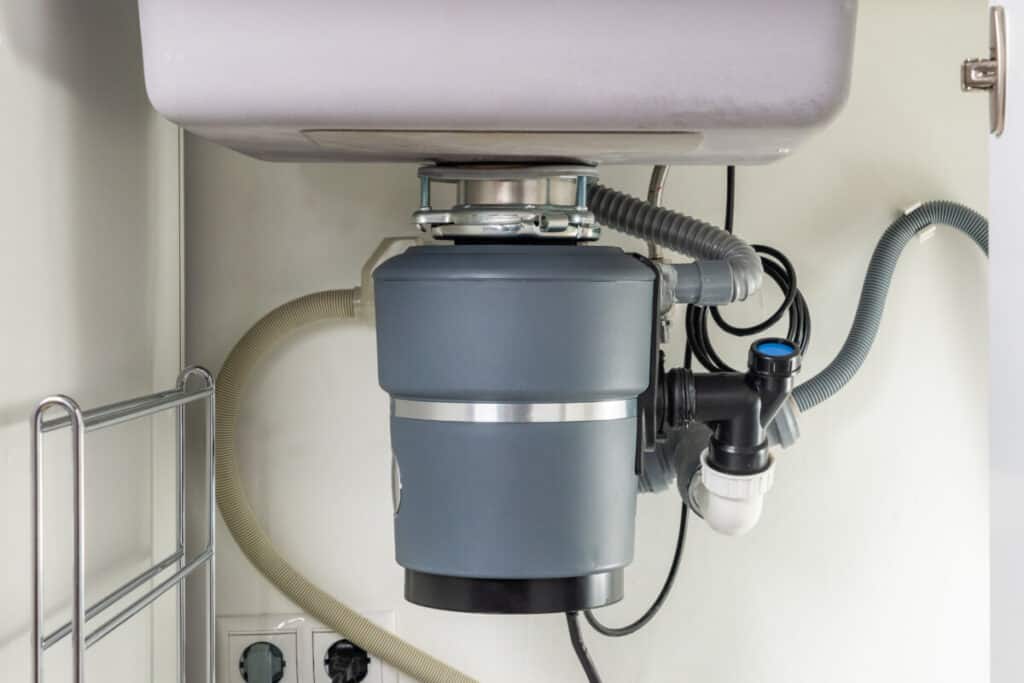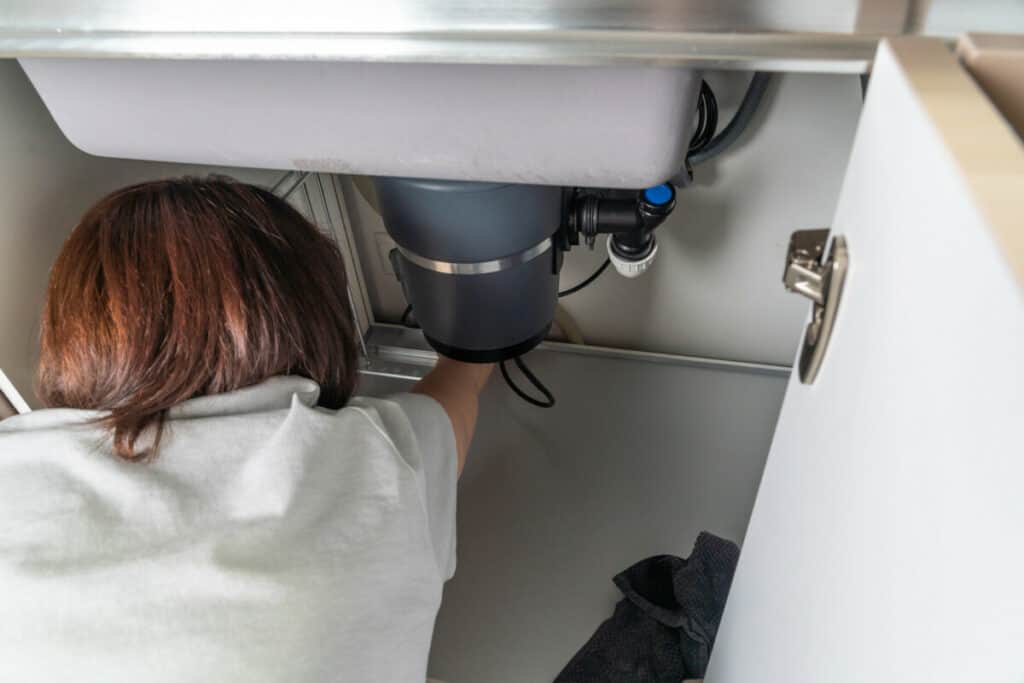Garbage disposals are a modern saving grace in the kitchen. They are always there to help get rid of crumbs from the counter, scraps from cooking, or unwanted foods that are too unseemly to empty by hand. With all this use, it is a wonder that every garbage disposal isn’t clogged- but even if they are clogged, should they be emptied?
Yes, garbage disposals should be emptied when clogged. Emptying should be done only when the disposal is not working or when the disposal, drain, or tubes are clogged. This deep cleaning can be done with various household cleaning products and will only take about 15 minutes.
If you suspect your garbage disposal needs emptying, this article is the place for you. Read on to find out why garbage disposals get clogged and see the best ways to fix them.
Why Your Disposal Is Clogged
Garbage disposals are overwhelmingly useful, but they can be frustrating at times.
If your garbage disposal seems slower, weaker, and smellier than usual, there is a good chance it is clogged and in need of emptying.
You may be confused as to why or how your garbage disposal is clogged, but it is easier to clog than most people would assume. Garbage disposals are tough machines, but putting the wrong things in, putting too much food in, or cleaning the disposal improperly can damage or clog your garbage disposal.

One of the main causes of garbage disposal clogging is improper disposal.
When using a garbage disposal, most people put their food in the sink, wash it down using hot water, turn on the disposal until the food is ground, then turn off the disposal and the water.
This is often the way garbage disposals are used, but it is not the way they should be used.
Instead, you should put your food in the sink, wash it down using cold water, turn on the disposal until the food is ground, turn off the disposal, then leave the cold water running for about fifteen seconds after the grinding stops.
Though hot water does break food down, it also softens food, meaning that the things you put in the disposal are much more likely to become gummy, sticky, or oily- in other words, hot water makes food much more likely to clog the disposal.
Another way that garbage disposals get clogged is by putting too much food in at once.
As mentioned earlier, garbage disposals are strong but they require proper care. One improper use for garbage disposals is as a trash can.
When using a garbage disposal, you should be careful how much food you put in at once. You shouldn’t be dumping entire containers of leftovers, a pile of carrot ends, or a handful of meat scraps in all at once.
These items can be put in the disposal, but you should be putting 1/2 cup of food or less in your garbage disposal at a time. This ensures that the blades are exposed enough to work together in the grinding process, that your disposal is strong enough to grind the food you put in, and that the food is ground up small enough to go down the drain.
If you are putting more than 1/2 a cup of food in at once or if your food chunks are larger than about 1 square inch, you are in danger of clogging your garbage disposal.
The last (and probably most common) way that garbage disposals are clogged is by people putting the wrong things down the disposal.
Garbage disposals are equipped to dispose of many things, but there are limits to their power.

Common foods that should not go in your garbage disposal are:
- Potato peels: Potato peels can be mashed up and clump together in the drain, later on, clogging not only the disposal but the pipes, too.
- Large ice cubes: Many people use large ice cubes to “sharpen the blades” of their garbage disposals, but this is damaging. Garbage disposal blades are meant to be blunt as they are designed to grind, not slice. Large ice cubes are often too rough on the blades and will cause your disposal to deteriorate faster than usual.
- Animal bones: The only animal bone that a garbage disposal can safely dispose of is a chicken bone. Larger, stronger bones (such as pig or cow bones) are too tough for your disposal to grind without damaging the blades.
- Foods that expand: Foods such as rice, bread, and noodles can expand greatly in water, and the same goes for these foods in the garbage disposal. This expansion causes clumping, thickening, and hardening of the foods in the drain, all of which will clog your garbage disposal.
Why You Should Empty Your Disposal
Now that you know how garbage disposals are clogged, let’s go over why you should empty your disposal, even if you think it isn’t clogged.
Signs that you should clean out your disposal are:
- It is no longer working
- It is weaker than usual
- It makes an odd sound
- It smells bad
All four of these are great reasons to empty your disposal, and we’ll tell you why.
If Your Disposal Isn’t Working…
If your disposal isn’t working, you should empty it because it is probably clogged.
Letting it sit can cause bacteria to grow, make the blades rust, and damage your plumbing.
If Your Disposal Is Weaker Than Usual…
Weak disposals usually point to a piece of hard food (such as a bone or large vegetable) or a foreign object being stuck between the blades of your garbage disposal.
These things should be removed to prevent further damage to your garbage disposal.
If Your Disposal Makes An Odd Sound…
Odd sounds can mean any number of things.
Your disposal could have broken blades, you could have a utensil stuck in the drain, or you could have intense clogging.
No matter the cause, the odd sound is probably causing damage to your disposal or drain and should be taken care of.
If Your Disposal Smells Bad…
Bad smells coming from your disposal are a guarantee that bacteria is growing there.
This bacteria could be on the rubber flaps of your disposal, it could be growing on a sneaky piece of food, or it could be resting on the blades of your disposal.
No matter where it is, it can be dangerous (such as Salmonella or E-coli) and cleaned as soon as possible.

How To Empty Your Disposal
No matter the reason for emptying your disposal, there are ways to go about it.
The three most common methods are using ice and salt, baking soda and vinegar, and dish soap. Each of these methods can be done separately, but if needed, they can be combined.
Before you start any deep cleaning method it is wise to check for visible clogging in the part of the disposal you can look into.
To check for clogging, unplug or turn off your disposal, then get a flashlight and look into the garbage disposal, using a utensil to move the rubber flaps out of your way if needed.
If you see food or other items that need to be removed, use long needlenose pliers to dislodge the food from the blades and take it out of the disposal. You should never put your bare hand into a garbage disposal, even when the power is off.
Once all visible debris is removed, check the function of your disposal.
If you think it needs to be completely emptied, pick one (or all) of the following methods to solve the problem.
Ice And Salt
Supplies:
- Chopped ice cubes
- 1/2 cup of rock salt
After you have removed all visible debris from your disposal, take your chopped or crushed ice cubes and place them into the garbage disposal.
You should not fill it to the top, but put at least 1 cup of ice at your disposal.
Once you’ve done this, take the rock salt and pour it into your disposal, then plug it in and turn it on.
As the ice is grinding, turn your water on to cold and let it run down the drain for about a minute before you turn the disposal off again.
Baking Soda And Vinegar
Supplies:
- 1/2 cup of Baking Soda
- 1 cup of Vinegar
- Bowl
- Old toothbrush
For this method, pour the vinegar and baking soda into the disposal and let it sit for about 15 minutes.
While these are sitting at your disposal, create a baking soda and vinegar paste in a bowl.
Take an old toothbrush and using this paste, scrub the rubber flaps of your garbage disposal. This will remove bacteria such as salmonella and E. coli, making any unwanted smells go away.
After the 15 minutes are up, turn on your disposal and use your tap water to wash down any debris that came up from your cleaning, as well as the residue from the baking soda and vinegar mix.
Dish Soap
Supplies:
- Dish soap
This is surely the simplest cleaning method.
All you need to do is plug your drain, fill up your sink with water, and add dish soap.
When your sink is about 3/4 of the way full, unplug the drain and turn on the garbage disposal.
The gravity of the water going down the drain paired with the suction of the garbage disposal will quickly wash away any debris or smells.

Extreme Measures
If none of these methods worked for you, there is still hope.
One easy way to remove deep clogs from your disposal without getting the toolbox out is to use a plunger.
Simply place your plunger on the hole of your garbage disposal and start pumping. If there is anything lodged deep inside, the plunger will surely help remove it in no time.
Related Topics:
If you like the article above, here are some other similar articles you should check out!
How Do You Clean Garbage Disposals?
